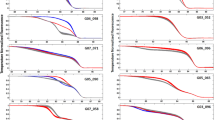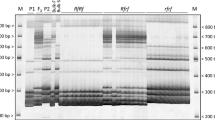Abstract
Spinach is basically a dioecious species, with occasional monoecious plants in some populations. Sexual dimorphism in dioecious spinach plants is controlled by an allelic pair termed X and Y located on the short arm of the longest chromosome (x = 6). Ten AFLP markers, closely linked to the X/Y locus, were identified using bulked segregant analysis, four of which were revealed to co-segregate with Y in the present mapping population. We mapped the AFLP markers and two known male-specific DNAs to a 13.4 cM region encompassing the locus. These markers will be the basis for positional cloning of the sex-determination gene. We also showed that a single, incompletely dominant gene is responsible for the highly staminate monoecious character. The gene was found to be located at a distance of 4.3 cM from microsatellite marker SO4, which mapped 1.6 cM from the X/Y locus. This indicates that the monoecious gene seems not to be allelic to but closely linked to the X/Y gene pair. SO4 will enable breeders to efficiently select highly male monoecious plants for preferential use as the pollen parent for hybrid seed production.


Similar content being viewed by others
Explore related subjects
Discover the latest articles and news from researchers in related subjects, suggested using machine learning.References
Akamatsu T, Suzuki T, Uchimiya H (1998) Determination of male or female of spinach by using DNA marker. Sakata no tane KK, Japan
Armstrong SJ, Filatov DA (2008) A cytogenetic view of sex chromosome evolution in plants. Cytogenet Genome Res 120:241–246
Bemis WP, Wilson GB (1953) A new hypothesis explaining the genetics of sex determination in Spinacia oleracea L. J Hered 44:91–95
Bergero R, Charlesworth D (2009) The evolution of restricted recombination in sex chromosomes. Trends Ecol Evol 24:94–102
Bernasconi G, Antonovics J, Biere A, Charlesworth D, Delph LF, Filatov D, Giraud T, Hood ME, Marais GAB, McCauley D, Pannell JR, Shykoff JA, Vyskot B, Wolfe LM, Widmer A (2009) Silene as a model system in ecology and evolution. Heredity 103:5–14
Chailakhyan M (1979) Genetic and hormonal regulation of growth, flowering, and sex expression in spinach. Am J Bot 66:717–736
Charlesworth B (1991) The evolution of sex-chromosomes. Science 251:1030–1033
Charlesworth D (2002) Plant sex determination and sex chromosomes. Heredity 94–101
Charlesworth D (2004) Plant evolution: modern sex chromosomes. Curr Biol 271–273
Doyle JJ, Doyle JL (1990) A rapid total DNA preparation procedure for fresh leaf tissue. Focus 12:13–15
Ellis JR, Janick J (1960) The chromosomes of Spinacia oleracea. Am J Bot 47:210–214
Golenberg EM (2000) Floral developmental regulation and sexual lability in spinach. Am Zool 40:1031s
Iizuka M, Janick J (1962) Cytogenetic analysis of sex determination in Spinacia oleracea. Genetics 47:1225–1241
Iizuka M, Janick J (1963) Sex chromosomes translocations in Spinacia oleracea L. Genetics 48:273–282
Iizuka M, Janick J (1966) The synthesis of heteromorphic sex chromosomes in spinach. J Hered 57:182–184
Jamilena M, Mariotti B, Manzano S (2008) Plant sex chromosomes: molecular structure and function. Cytogenet Genome Res 120:255–264
Janick J (1955) Inheritance of sex in tetraploid spinach. Proc Am Soc Hortic Sci 66:361–363
Janick J (1998) Hybrids in horticultural crops. In: Lamkey KR, Staub JE (eds) Concepts and breeding of heterosis in crop plants. Crop Science Society of America, pp 45–56
Janick J, Stevenson EC (1954) A genetic study of the heterogametic nature of the staminate plant in spinach. Proc Am Soc Hortic Sci 63:444–446
Janick J, Stevenson EC (1955a) Environmental influences on sex expression in monoecious lines of spinach. Proc Am Soc Hortic Sci 65:416–422
Janick J, Stevenson EC (1955b) Genetics of the monoecious character in spinach. Genetics 40:429–437
Janick J, Stevenson EC (1955c) The effects of polyploidy on sex expression in spinach. J Hered 46:150–156
Janick J, Mahoney DL, Pfahler PL (1959) The trisomics of Spinacia oleracea. J Hered 50:46–50
Katayama Y, Shida S (1956) Development of intersexual flowers and their location on the stalk in spinach. Jpn J Breed 6:19–22
Kawasaki S, Kamihara K, Motomura T, Kodama O (2000) Compact high density AFLP enabled high efficiency genome scanning. In: 4th international rice genetics symposium, International Rice Research Institute, p 73
Khattak J, Torp A, Andersen S (2006) A genetic linkage map of Spinacia oleracea and localization of a sex determination locus. Euphytica 148:311–318
Koh HJ, Heu MH, McCouch SR (1996) Molecular mapping of the ge(S) gene controlling the super-giant embryo character in rice (Oryza sativa L.). Theor Appl Genet 93:257–261
Kosambi DD (1944) The estimation of map distance from recombination values. Ann Eugen 12:172–175
Lan T, Zhang S, Liu B, Li X, Chen R, Song W (2006) Differentiating sex chromosomes of the dioecious Spinacia oleracea L. (spinach) by FISH of 45S rDNA. Cytogenet Genome Res 175–177
Lander ES, Green P, Abrahamson J, Barlow A, Daly MJ, Lincoln SE, Newberg LA (1987) MAPMAKER: an interactive computer package for constructing primary genetic linkage maps of experimental and natural populations. Genomics 1:174–181
Mariotti B, Manzano S, Kejnovsky E, Vyskot B, Jamilena M (2009) Accumulation of Y-specific satellite DNAs during the evolution of Rumex acetosa sex chromosomes. Mol Genet Genomics 281:249–259
Ming R, Wang J, Moore P, Paterson A (2007) Sex chromosomes in flowering plants. Am J Bot 141–150
Morelock TE, Correll JC (2008) Spinach. In: Prohens J, Nuez F (eds) Vegetables I, pp 189–218
Onodera Y, Yonaha I, Niikura S, Yamazaki S, Mikami T (2008) Monoecy and gynomonoecy in Spinacia oleracea L.: morphological and genetic analyses. Sci Hortic 118:266–269
Pfent C, Pobursky K, Sather D, Golenberg E (2005) Characterization of SpAPETALA3 and SpPISTILLATA, B class floral identity genes in Spinacia oleracea, and their relationship to sexual dimorphism. Dev Genet Evol 215:132–142
Rosa J (1925) Sex expression in spinach. Hilgardia 1:259–274
Sather DN, Golenberg EM (2009) Duplication of AP1 within the Spinacia oleracea L. AP1/FUL clade is followed by rapid amino acid and regulatory evolution. Planta 229:507–521
Sather DN, York A, Pobursky K, Golenberg EM (2005) Sequence evolution and sex-specific expression patterns of the C class floral identity gene, SpAGAMOUS, in dioecious Spinacia oleracea L. Planta 284–292
Sather DN, Jovanovic M, Golenberg EM (2010) Functional analysis of B and C class floral organ genes in spinach demonstrates their role in sexual dimorphism. BMC Plant Biol10
Sherry R, Eckard K, Lord E (1993) Flower development in dioecious Spinacia oleracea (Chenopodiaceae). Am J Bot 283–291
Telgmann-Rauber A, Jamsari A, Kinney MS, Pires JC, Jung C (2007) Genetic and physical maps around the sex-determining M-locus of the dioecious plant asparagus. Mol Genet Genomics 278:221–234
Thompson AE (1954) The extent of natural crossing in inbred monecious spinach lines. Proc Am Soc Hortic Sci 64:405–409
Thompson AE (1955) Methods of producing first-generation hybrid seed in spinach. Cornell Agric Exp Sta Mem 336:1–48
van der Vossen HAM (1993) Spinacia oleracea L. In: Siemonsma JS, Piluek K (eds) PROSEA, plant resources of South-East Asia. Pudoc Scientific Publishers, Wageningen
van der Vossen HAM (2004) Spinacia oleracea L. In: Grubben GJH, Denton OA (eds) PROTA 2: vegetables/legumes. PROTA, Wageningen
Vos P, Hogers R, Bleeker M, Reijans M, Vandelee T, Hornes M, Frijters A, Pot J, Peleman J, Kuiper M, Zabeau M (1995) AFLP: a new technique for DNA-fingerprinting. Nucleic Acids Res 23:4407–4414
Wu X, Wang JP, Na JK, Yu QY, Moore RC, Zee F, Huber SC, Ming R (2010) The origin of the non-recombining region of sex chromosomes in Carica and Vasconcellea. Plant J 63:801–810
Yin T, DiFazio SP, Gunter LE, Zhang X, Sewell MM, Woolbright SA, Allan GJ, Kelleher CT, Douglas CJ, Wang M, Tuskan GA (2008) Genome structure and emerging evidence of an incipient sex chromosome in Populus. Genome Res 18:422–430
Yu QY, Hou S, Feltus FA, Jones MR, Murray JE, Veatch O, Lemke C, Saw JH, Moore RC, Thimmapuram J, Liu L, Moore PH, Alam M, Jiang JM, Paterson AH, Ming R (2008) Low X/Y divergence in four pairs of papaya sex-linked genes. Plant J 53:124–132
Acknowledgments
We thank Professor Jules Janick for fruitful discussions. We are grateful to Mino Nakaya for technical assistance. This work was supported by Grants in Aid for Scientific Research from the Ministry of Education, Culture, Sports, Science, and Technology, Japan.
Author information
Authors and Affiliations
Corresponding author
Additional information
Communicated by K. Toriyama.
Y. Onodera, I. Yonaha and H. Masumo contributed equally to this work.
Electronic supplementary material
Below is the link to the electronic supplementary material.
Rights and permissions
About this article
Cite this article
Onodera, Y., Yonaha, I., Masumo, H. et al. Mapping of the genes for dioecism and monoecism in Spinacia oleracea L.: evidence that both genes are closely linked. Plant Cell Rep 30, 965–971 (2011). https://doi.org/10.1007/s00299-010-0998-2
Received:
Revised:
Accepted:
Published:
Issue Date:
DOI: https://doi.org/10.1007/s00299-010-0998-2




